| Author |
Message |
|
Harry J. Fletcher
|
 Posted: Thu 07 Jan, 2010 5:52 pm Post subject: Hanwei Shinto Elite - Katana for Combat Posted: Thu 07 Jan, 2010 5:52 pm Post subject: Hanwei Shinto Elite - Katana for Combat |
 |
|
In my cutting exercises I find a preference for a curved blade over a straight medieval blade. While some of the two handed and bastard medieval blades give more power to the blade stroke I find this is either to smash through mail and deliver a cut or to deliver a blunt trauma percussive blow. If one wants to deliver a cut it is more like a chop with a clever while with a curved blade there is more of a cutting action.
I prefer the Katana for its curved blade and its agility. A Kalij, Scimitar, Talwar all have curved blades too but only use one hand and lack in my opinion the flexibility of the katana. The Hanwei Shinto Elite 2 lbs 11oz is a perfect compromise for cutting power, handling, agility, and weight. It was designed for cutting tatami omote which depending on the thickness of the rolled mats can similulate a human limb or a torso when properly soaked in water. While I own a Hanwei Shinto 1 lb 11oz it has a Bo Hi, the wide groove between the shinogi and the mune of the blade which makes for a fast, agile, and very quick blade capable of making very quick cuts I prefer the more traditional profile of the heavier blade of the Shinto Elite for cutting.
Since cutting one's opponent is sine qua non of the exercise, it is not how quickly several cuts can be made but how lethal the cut is when it is made. A curved blade cuts better and a curved, heavier blade digs in deeper as it cuts due to its weight. While weight is an asset it can also be too much.
I have a Cheness Specialized Goza Cutter which is a heavy blade designed for heavy cutting. I have cut with it and it will cut very well but it is a slow handling blade. Not clumsy mind you , but heavy compared to a regular katana.
Both the Hanwei Shinto and Shinto Elite are made from T10 steel and both are differentially tempered. THese blades are made in about the same way as the New Sword period (beginning 1500 AD).
I have attached a couple of pictures. The first shows the Shinto Elite (nearest katana, Shinto, and Cheness SGC) and the next picture shows the Cheness SBG.
 Attachment: 205.48 KB Attachment: 205.48 KB
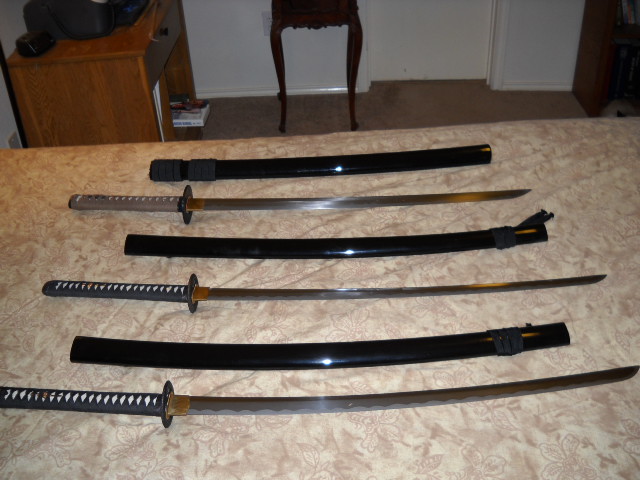
 Attachment: 204.1 KB Attachment: 204.1 KB
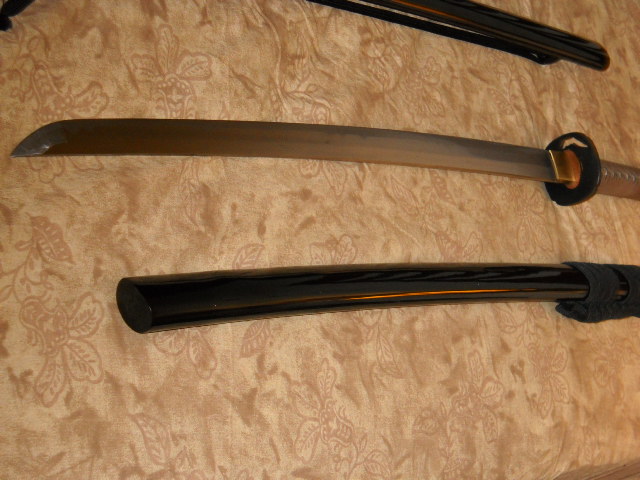
To Study The Edge of History
Last edited by Harry J. Fletcher on Fri 08 Jan, 2010 12:13 pm; edited 1 time in total
|
|
  |
 |
M. Eversberg II

|
 Posted: Fri 08 Jan, 2010 3:40 am Post subject: Posted: Fri 08 Jan, 2010 3:40 am Post subject: |
 |
|
Could I get a close up of the wraps? Also, out of curiosity is the kissaki cosmetic or beveled?
M.
This space for rent or lease.
|
|
      |
 |
|
Harry J. Fletcher
|
 Posted: Fri 08 Jan, 2010 4:24 pm Post subject: Pics of Tsuka Ito and Kissaki Posted: Fri 08 Jan, 2010 4:24 pm Post subject: Pics of Tsuka Ito and Kissaki |
 |
|
M. Eversberg II here are pictures of the Tsuka Ito as requested and of the kissaki which was hard to capture but hope you can get some detail. The Tsuka Ito is cotton cord wrapped around rayskin. The kissaki is well done and really finished quite nicely.
Regards,
Harry
 Attachment: 201.99 KB Attachment: 201.99 KB
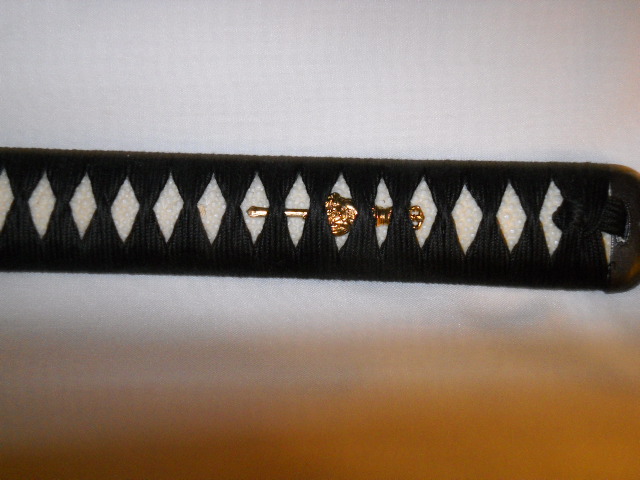
 Attachment: 190.45 KB Attachment: 190.45 KB
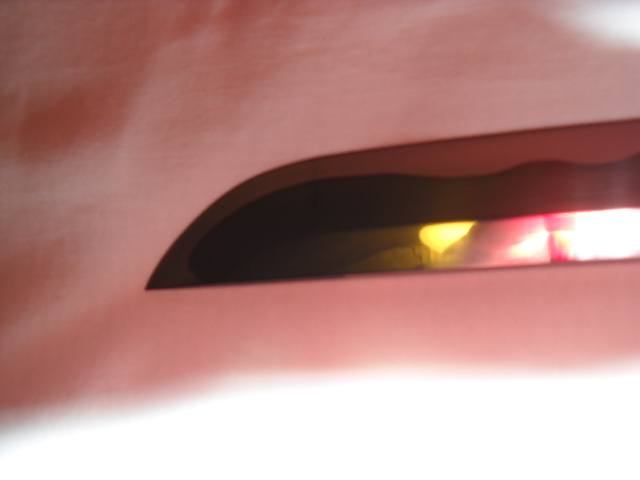
 Attachment: 190.45 KB Attachment: 190.45 KB
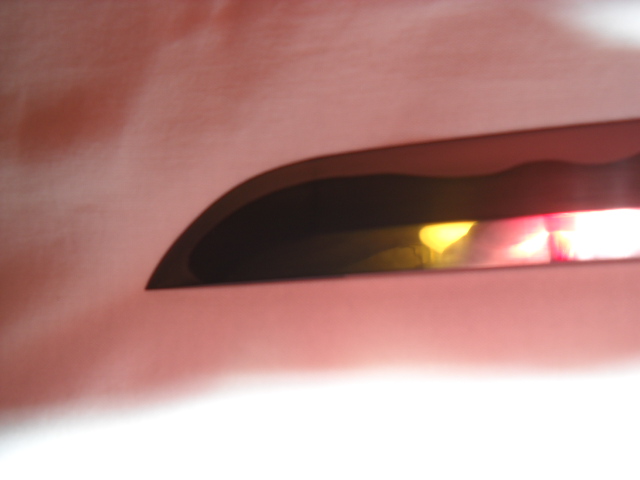
To Study The Edge of History
|
|
  |
 |
|
P. Cha
|
 Posted: Fri 08 Jan, 2010 8:34 pm Post subject: Posted: Fri 08 Jan, 2010 8:34 pm Post subject: |
 |
|
|
The shinto elite has a geometric yokote(or at least it use to). It however still does not have a traditional geometry. I would not be comfortable with a shinto katana if I had to use it for a real sword fight. It is thinner then it really should be. Good for cutting mats though.
|
|
  |
 |
|
Harry J. Fletcher
|
 Posted: Sat 09 Jan, 2010 12:17 pm Post subject: Yokote on Shinto Elite Posted: Sat 09 Jan, 2010 12:17 pm Post subject: Yokote on Shinto Elite |
 |
|
Yes, the Shinto Elite still has the a yokote but the pic did not show it due to the high polish of the o-kissaki. In fact one must look closely with the naked eye due the polish and light.
Thanks for mentioning this as I had not considered it before.
Regards,
Harry
To Study The Edge of History
|
|
  |
 |
M. Eversberg II

|
 Posted: Mon 11 Jan, 2010 11:32 am Post subject: Posted: Mon 11 Jan, 2010 11:32 am Post subject: |
 |
|
Not a bad piece for a production kat. I've always leaned closer to the wakizashi for earlier period blades, and gunto for later period ones. Is the hamon wire or acid based?
M.
This space for rent or lease.
|
|
      |
 |
|
Harry J. Fletcher
|
 Posted: Mon 11 Jan, 2010 3:25 pm Post subject: Hamon is Real Posted: Mon 11 Jan, 2010 3:25 pm Post subject: Hamon is Real |
 |
|
The hamon is real due to differential clay tempering. Although a monosteel blade it is tempered using the traditional clay method giving a harder Ha machi (edge) and a softer sword body. I have actually ribboned paper hanging from a clothes line with the Shinto. When you think of the money spent you get what you pay for with these Katanas. They, both the Shinto and Shinto Elite, have now been discontinued for whatever reason I don't know.
The Cheness blades especially the SGC are acid etched but due to the thickness of the steel in the blade the edge will cool much more quickly than the rest of the thicker body of the blade. While untentional this would give the blade a hamon as well but not due to clay tempering.
To Study The Edge of History
|
|
  |
 |
|
Pohan Leu
Location: Irvine, CA Joined: 16 Jan 2010
Posts: 1
|
 Posted: Sun 17 Jan, 2010 11:55 am Post subject: Posted: Sun 17 Jan, 2010 11:55 am Post subject: |
 |
|
Is the hamon first etched on this Shinto and Shinto Elite blades? Or is it actually done the painstainking old school way with a million stones?
http://www.leucustom.com
|
|
   |
 |
|
Ole W.
Location: Norway Joined: 21 Jan 2009
Posts: 15
|
 Posted: Sun 17 Jan, 2010 1:45 pm Post subject: Re: Hanwei Shinto Elite - Katana for Combat Posted: Sun 17 Jan, 2010 1:45 pm Post subject: Re: Hanwei Shinto Elite - Katana for Combat |
 |
|
| Harry J. Fletcher wrote: | | While some of the two handed and bastard medieval blades give more power to the blade stroke I find this is either to smash through mail and deliver a cut or to deliver a blunt trauma percussive blow. If one wants to deliver a cut it is more like a chop with a clever while with a curved blade there is more of a cutting action. |
I don't think it is possible to cut through mail. Also, percussive weapons, not swords, would be used to deliver percussive blows. Furthermore, I would like you to source your statement that curved blades cut better than straight blades.
The most dedicated European cutting swords, such as execution swords and large, two handed swords of type XIIa and XIIIa as well as Zweihänder tended to be straight, double edged swords. The first Guillotines had curved blades. Later the straight bladed Guillotine was introduced in order to cut more efficiently.
It seems to me that curved blades often appear to be an adaption for mounted warfare, not "superior cutting".
Lastly, I must admit that I wonder whether "agile" is a suitable defining characteristic for a sword which is heavier relative to length than most European swords, in addition to possessing a thicker cross section.
That being said, those are some very beautiful swords pictured.
|
|
  |
 |
|
Nicholas Allan Wilson
Location: New Orleans Joined: 16 Feb 2009
Posts: 70
|
 Posted: Sun 17 Jan, 2010 4:22 pm Post subject: Re: Hanwei Shinto Elite - Katana for Combat Posted: Sun 17 Jan, 2010 4:22 pm Post subject: Re: Hanwei Shinto Elite - Katana for Combat |
 |
|
[quote="Ole W."] | Harry J. Fletcher wrote: |
The most dedicated European cutting swords, such as execution swords and large, two handed swords of type XIIa and XIIIa as well as Zweihänder tended to be straight, double edged swords. The first Guillotines had curved blades. Later the straight bladed Guillotine was introduced in order to cut more efficiently.
|
A Guillotine is not a sword. And the blades of guillotines moved in a straight line (unless I'm mistaken) and guided by a wooden frame. The resulting effect would be a shearing of sorts, not a cut. There seems to be a disagreement as to what a cut exactly is as this argument repeatedly pops up.
|
|
  |
 |
|
Nicholas Allan Wilson
Location: New Orleans Joined: 16 Feb 2009
Posts: 70
|
 Posted: Sun 17 Jan, 2010 4:43 pm Post subject: Re: Hanwei Shinto Elite - Katana for Combat Posted: Sun 17 Jan, 2010 4:43 pm Post subject: Re: Hanwei Shinto Elite - Katana for Combat |
 |
|
[quote="Ole W."] | Harry J. Fletcher wrote: |
The most dedicated European cutting swords, such as execution swords and large, two handed swords of type XIIa and XIIIa as well as Zweihänder tended to be straight, double edged swords. |
And it is important to note that in Japan, executions were carried out on criminals to test newly forged katana. Some could cut as many as five bodies in a single stroke.
source:
http://www.pbs.org/wgbh/nova/samurai/
you'll have to watch the doc to see the part I'm talking about.
~nic
|
|
  |
 |
|
Harry J. Fletcher
|
 Posted: Sun 17 Jan, 2010 7:36 pm Post subject: Misquote by Mr. Wilson Though we are in Agreement Posted: Sun 17 Jan, 2010 7:36 pm Post subject: Misquote by Mr. Wilson Though we are in Agreement |
 |
|
This was said by Mr. Ole W not by me::
The most dedicated European cutting swords, such as execution swords and large, two handed swords of type XIIa and XIIIa as well as Zweihänder tended to be straight, double edged swords. The first Guillotines had curved blades. Later the straight bladed Guillotine was introduced in order to cut more efficiently.
_____________________________________________________________________________________________
Just wanted to set the record straight although Mr. Wilson and I are in agreement about the cutting ability of the katana.
As for cutting mail the sword usually burst the links apart rather than "cut" through them. If Mr. Ole W doubts the percussive effect of a sword to a person wearing mail then let him don a mail hauberk and have a rather strong person strike a lively blow with a type X sword. Remember, the men who were wielding these swords were the supremely fit athletes of their day. They had to be since they were professionals.
If one analyzes cutting with a straight blade, the straight edge first makes contact with the target and forces its way into the target like a wedge then it must be drawn back to effect a cutting action. If this action is not in two parts it is more like that of a clever blow. In using a katana it takes only one fluid action to effect a deep cut with much less force than a two handed medeival broadsword. In one episode of Weapon Masters a katana of traditional mfg was against traditional Samuari armor and it cut through. James Williams, America's cutting Champion did the cutting I think. Numerous demonstrations I have seen show the effectiveness of the katana in cutting. As for the Guillotine it cannot duplicate the same cutting motion as a human. Additionally, the Guillotine's blade was changed to a slanting shape which gave a similar slicing action to that of a katana.
When it is all said and done my cutting tests have shown that the Katana works best for me and vindicates other tests which I have watched. Can a Medeival European sword cut? Yes. Can it with less effort? In my opinion no.
Regards,
Harry
To Study The Edge of History
|
|
  |
 |
|
Nicholas Allan Wilson
Location: New Orleans Joined: 16 Feb 2009
Posts: 70
|
 Posted: Sun 17 Jan, 2010 10:35 pm Post subject: Posted: Sun 17 Jan, 2010 10:35 pm Post subject: |
 |
|
The notion of effort is a good point to make. I think a straight sword could do a lot of damage with regards to the cut. However, the effort required to match the cutting ability of a katana might be considerably more. After all a sword is a tool and tools are meant to make certain tasks easier.
It is also important not to forget proper body mechanics. Someone who uses their center more effectively would be more efficient than someone relying on strength alone. This is where effort ties in.
~nic[/u]
|
|
  |
 |
|
P. Cha
|
 Posted: Sun 17 Jan, 2010 10:36 pm Post subject: Re: Hanwei Shinto Elite - Katana for Combat Posted: Sun 17 Jan, 2010 10:36 pm Post subject: Re: Hanwei Shinto Elite - Katana for Combat |
 |
|
| Nicholas Allan Wilson wrote: | | Ole W. wrote: | | Harry J. Fletcher wrote: |
The most dedicated European cutting swords, such as execution swords and large, two handed swords of type XIIa and XIIIa as well as Zweihänder tended to be straight, double edged swords. |
And it is important to note that in Japan, executions were carried out on criminals to test newly forged katana. Some could cut as many as five bodies in a single stroke.
source:
http://www.pbs.org/wgbh/nova/samurai/
you'll have to watch the doc to see the part I'm talking about.
~nic |
|
Umm not to nit pick, but that source is rather questionable in it´s accuracy. In fact using TV shows as accurate resources is pretty much a bad idea.
As for cutting through 5 bodies...yes that is reported...course what the show ignores to tell you is that testing of the swords were done with a special tsuka (handle) that was upwards of 20+ inches long to produce extra power. The test wasn´t even about cutting, but a stress test of the edge to make sure it could take that much power. The point was to test the blade and that was it.
|
|
  |
 |
|
P. Cha
|
 Posted: Sun 17 Jan, 2010 11:00 pm Post subject: Re: Misquote by Mr. Wilson Though we are in Agreement Posted: Sun 17 Jan, 2010 11:00 pm Post subject: Re: Misquote by Mr. Wilson Though we are in Agreement |
 |
|
| Harry J. Fletcher wrote: |
As for cutting mail the sword usually burst the links apart rather than "cut" through them. If Mr. Ole W doubts the percussive effect of a sword to a person wearing mail then let him don a mail hauberk and have a rather strong person strike a lively blow with a type X sword. Remember, the men who were wielding these swords were the supremely fit athletes of their day. They had to be since they were professionals. |
I don´t think you realize how armor works...especially chain mail. Even butted mails are hard to cut through, much less riveted mail. The reason nobody is gonna take that challenge is because while armor does negate quite a lot of damage done by weapons, it does NOT make one invulnerable. And to request such a challenge is irresponsible, dangerous and shows you have a complete lack of wisdom and knowledge. Other tests have been done (SAFELY) about how effective armor works.
| Quote: | If one analyzes cutting with a straight blade, the straight edge first makes contact with the target and forces its way into the target like a wedge then it must be drawn back to effect a cutting action. If this action is not in two parts it is more like that of a clever blow. In using a katana it takes only one fluid action to effect a deep cut with much less force than a two handed medeival broadsword. In one episode of Weapon Masters a katana of traditional mfg was against traditional Samuari armor and it cut through. James Williams, America's cutting Champion did the cutting I think. Numerous demonstrations I have seen show the effectiveness of the katana in cutting. As for the Guillotine it cannot duplicate the same cutting motion as a human. Additionally, the Guillotine's blade was changed to a slanting shape which gave a similar slicing action to that of a katana.
When it is all said and done my cutting tests have shown that the Katana works best for me and vindicates other tests which I have watched. Can a Medeival European sword cut? Yes. Can it with less effort? In my opinion no.
Regards,
Harry |
Umm you do realize that you can slice while cutting with a straight edge. If you did such a motion with a katana, you will find to actually is harder to cut as the angle your blade meets will generate a lot of drag through the cutting medium. Most lazy cuts is easier with a katana...but once you get trained, either can cut just as well. However, for new people who have no training, katana is easier. Once you start to use the katana, learning the motions for euro swords become difficult...which is why a lot of mis-notions that euro swords can´t cut comes from. I started out using katana and now that I learned how to use euro swords, I cut just as well with my euro blades as my katana(well...barring type XV blades anyways...). But then again, nobody can dispute that a katana is feels better in your hands and cuts better in your hands...but don´t assume that it is a universal truth either.
|
|
  |
 |
|
Ole W.
Location: Norway Joined: 21 Jan 2009
Posts: 15
|
 Posted: Mon 18 Jan, 2010 1:46 pm Post subject: Re: Misquote by Mr. Wilson Though we are in Agreement Posted: Mon 18 Jan, 2010 1:46 pm Post subject: Re: Misquote by Mr. Wilson Though we are in Agreement |
 |
|
| Harry J. Fletcher wrote: |
If one analyzes cutting with a straight blade, the straight edge first makes contact with the target and forces its way into the target like a wedge then it must be drawn back to effect a cutting action. If this action is not in two parts it is more like that of a clever blow. In using a katana it takes only one fluid action to effect a deep cut with much less force than a two handed medeival broadsword. |
Mr. Harry J. Fletcher,
I am wondering whether you have ever held a European sword, or any other straight bladed sword? If so, have you ever attempted to cut with one?
Thanks,
Ole W.
|
|
  |
 |
|
Nicholas Allan Wilson
Location: New Orleans Joined: 16 Feb 2009
Posts: 70
|
 Posted: Mon 18 Jan, 2010 3:54 pm Post subject: Re: Hanwei Shinto Elite - Katana for Combat Posted: Mon 18 Jan, 2010 3:54 pm Post subject: Re: Hanwei Shinto Elite - Katana for Combat |
 |
|
| P. Cha wrote: | [
Umm not to nit pick, but that source is rather questionable in it´s accuracy. In fact using TV shows as accurate resources is pretty much a bad idea.
. |
Why is it a bad idea? Are you speaking in a general sense or are you being specific to this documentary? If so, why?
|
|
  |
 |
|
Nicholas Allan Wilson
Location: New Orleans Joined: 16 Feb 2009
Posts: 70
|
 Posted: Mon 18 Jan, 2010 4:10 pm Post subject: Re: Hanwei Shinto Elite - Katana for Combat Posted: Mon 18 Jan, 2010 4:10 pm Post subject: Re: Hanwei Shinto Elite - Katana for Combat |
 |
|
| P. Cha wrote: |
As for cutting through 5 bodies...yes that is reported...course what the show ignores to tell you is that testing of the swords were done with a special tsuka (handle) that was upwards of 20+ inches long to produce extra power. The test wasn´t even about cutting, but a stress test of the edge to make sure it could take that much power. The point was to test the blade and that was it. |
And I'm pretty sure that the tests were done for a variety of reasons. Cutting and durability were probably both an issue. However, I cannot see, and have never heard of, testing only being done to prove durability. There were a variety of tests the Japanese did during WW2 to test the strength of the blade by dropping weights at different points along the sword edge up, edge down, sideways, etc...
~nic
|
|
  |
 |
|
Harry J. Fletcher
|
 Posted: Mon 18 Jan, 2010 4:58 pm Post subject: Lot Of Ground To Cover Here Posted: Mon 18 Jan, 2010 4:58 pm Post subject: Lot Of Ground To Cover Here |
 |
|
In answer to Mr. Cha comment about me being irresponsible in suggesting Mr. Ole W. don a mail hauberk and subject himself to a blow from a sword, it was my intent to show that a sensible person would not take such a risk because of the great risk of being injured by such a blow thus making my point.
Secondly, I agree with Mr. Cha's comment that once being trained to make cuts with a katana it is very difficult to try cutting with a European type blade. I have used katanas to cut milk jugs filled with water, tatami omote, pool noodles, and to ribbon paper hung from a clothes line. I have used European medeival type x and type XVIII to cut milk jugs, and pool noodles. Most people agree that a curved blade cuts better than a straight blade and my cutting demonstates this for me. People who do a lot of cutting with European medeival blades develop technique and can cut tatami omote as well as a katana but in my opinion with more effort.
As I stated in my view the straight blade makes contact first and then is drawn while the a curved blade makes contact and is drawn with one fluid motion. Secondly, the European medeival blade gives a concussive effect even if does not cut while the katana was designed for cutting alone.
The heart of this debate is "...different strokes for different folks..."
Regards,
Harry
To Study The Edge of History
|
|
  |
 |
|
Timo Nieminen
|
 Posted: Mon 18 Jan, 2010 6:38 pm Post subject: Re: Hanwei Shinto Elite - Katana for Combat Posted: Mon 18 Jan, 2010 6:38 pm Post subject: Re: Hanwei Shinto Elite - Katana for Combat |
 |
|
| Nicholas Allan Wilson wrote: | | However, I cannot see, and have never heard of, testing only being done to prove durability. |
A particular test might be done only to prove durability. For example, the British proof test, the Japanese weight-drop tests you mentioned. (I hadn't heard of these - do you know a good source or a magic search word?) In an ideal world, a weapon always would be tested for function as well (and in the real world, usually will be tested so). But all swords of a particular pattern will cut soft targets approximately equally well if equally sharp, so there isn't a great need to test individual swords. A design needs to be tested for function, individual examples of that design need to be tested for durability. So most tests will address durability, with cutting possibly included to test e.g. durability of the edge - does it chip, roll, dull, etc.?
There's also design-level durability testing, as distinct from individual testing for quality control - more or less the goal of much of the "sword-testing" done by users/reviewers these days. (As distinct from "test-cutting", or even testing suitability for "test-cutting".)
|
|
   |
 |
|
|

